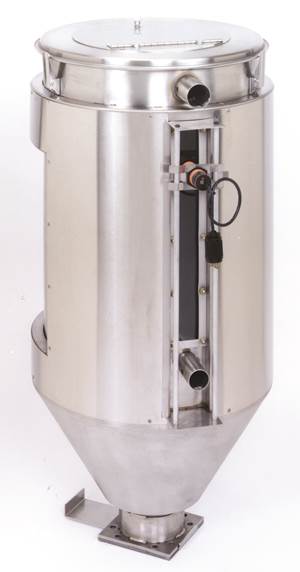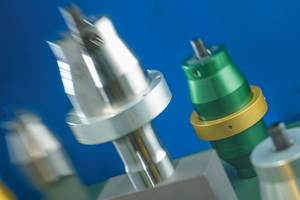EXTRUSION: Better Mix In Means Better Mix Out
Segregation or de-mixing of polymers and additives can be a big problem in single-screw extrusion. Here’s why it happens, and how to fix it.
There is a mixing principle in single-screw extrusion that always holds true: The better the mix entering the screw the better the final mix. Providing a better mix into the screw requires two things: A mixing procedure that first uniformly disperses the additives through the base polymer(s) and secondly prevents them from segregating before—or even as—the mix enters the screw.
The second requirement is particularly true of certain solids that cannot be sheared to take advantage of the dispersive-mixing effect that single screws provide. These include various mineral or metallic fillers that typically cannot be sheared into the base polymer because they do not melt or soften and tend to pass through the extruder with no changes in shape or size. Significant axial redistributive mixing of such materials is difficult to achieve on single screws because these extruders are surprisingly plug-like in flow, meaning the flow is very much “first in-first out.” This is related to the laminar flow of polymers in the single screw, and the predominant down-channel shear distribution in the channel, which results in restricted mixing in the axial direction.
Single screws also lack a significant mechanism for reorientation of the laminar interfaces formed, which greatly reduces the ability to perform “macro” mixing. Only high levels of pressure flow or head pressure result in significant axial mixing, but that also reduces output and raises melt temperature.
There is of course aggressive localized mixing in the screw channels, particularly as melting progresses and—to a lesser degree—after melting is complete. However, that does not provide the large-scale redistributive effect that many expect to happen in the screw. Processors are usually disappointed when they realize their screw will not mix various solid materials satisfactorily, and they usually believe the screw design(er) is at fault. Various screw geometries and mixer designs can divide numerous times and apply shear to the polymer/solid mixture, but are limited in large-scale redistribution.
It’s surprising to me how many processors haphazardly add solid additives to their extruder and expect it to somehow correct the distribution of these materials for a perfect mix at the discharge. The solids-feeding area of the extruder extends from well before the hopper to several flights down the screw, where the polymer and solids become compacted into a solid mass and movement is eliminated. Any time there is movement of the polymer-additive mix by rolling, sliding, vibrating, or flowing, there is the likelihood of de-mixing or separation (see illustration).
Particles that are flowing can separate based on differences in particle size, shape, frictional characteristics, surface roughness, and density. Separation can even happen at what would be considered relatively static locations, like a hopper. As a bench test to see if separation is likely, you can take the preferred mix, put it in a can, and shake it for a few minutes. When poured out evaluate how much the mix has segregated.
Segregation or de-mixing can occur at various points throughout the solids-transport system, so it’s usually best to perform the mixing of the solids with the base polymer(s) as close as possible to the screw flight entry to account for this possibility. Separation can be minimized in many cases by proper design of the piping and hoppers, and by altering particle characteristics.
For example, bulk-handling equipment can segregate the original mix based on velocities and velocity changes, which are governed by particle density, shape, and size. The shape of the hopper alone can cause segregation, with smaller particles tending to channel, depending on the slopes of the surfaces and angle of repose of the particle components. Smaller particles can even flow through the larger particles, causing separation, such as with fine powders.
Particles with much higher densities, such as metallic fillers, will segregate based on weight. Friction on the walls of the solids flow surfaces, such as the hopper walls, varies with the solid additive as well as surface roughness and frictional coefficient. Additionally, there is particle-to-particle friction that can cause segregation. Generally, the more different the filler particles are from the polymer pellets in any of these parameters, the more easily segregation can occur.
By varying the design, single screws can do a good to very good job of localized mixing of polymers and additives that can be melted or softened. But mixing additives that do not melt is more difficult, since they cannot take advantage of the naturally occurring shear-induced mixing from the screw rotation. “Better mix in-better mix out” particularly holds for those applications. You’ll avoid a lot of problems by keeping in mind that the initial mixing is not necessarily the mix that arrives in the screw.
ABOUT THE AUTHOR
Jim Frankland is a mechanical engineer who has been involved in all types of extrusion processing for more than 40 years. He is now president of Frankland Plastics Consulting, LLC. Contact jim.frankland@comcast.net or (724) 651-9196.
Related Content
The Effects of Time on Polymers
Last month we briefly discussed the influence of temperature on the mechanical properties of polymers and reviewed some of the structural considerations that govern these effects.
Read MoreThe Importance of Barrel Heat and Melt Temperature
Barrel temperature may impact melting in the case of very small extruders running very slowly. Otherwise, melting is mainly the result of shear heating of the polymer.
Read MoreBozzelli’s Guide To Specifying a Dryer
Here's a list of 17 things to do when looking for new drying equipment.
Read MoreUltrasonic Welding: Tips, Techniques, and Troubleshooting
In this collection of content, we provide expert advice on welding from some of the leading authorities in the field, with tips on such matters as controls, as well as insights on how to solve common problems in welding.
Read MoreRead Next
People 4.0 – How to Get Buy-In from Your Staff for Industry 4.0 Systems
Implementing a production monitoring system as the foundation of a ‘smart factory’ is about integrating people with new technology as much as it is about integrating machines and computers. Here are tips from a company that has gone through the process.
Read MoreLead the Conversation, Change the Conversation
Coverage of single-use plastics can be both misleading and demoralizing. Here are 10 tips for changing the perception of the plastics industry at your company and in your community.
Read MoreMaking the Circular Economy a Reality
Driven by brand owner demands and new worldwide legislation, the entire supply chain is working toward the shift to circularity, with some evidence the circular economy has already begun.
Read More
.jpg;width=70;height=70;mode=crop)





















